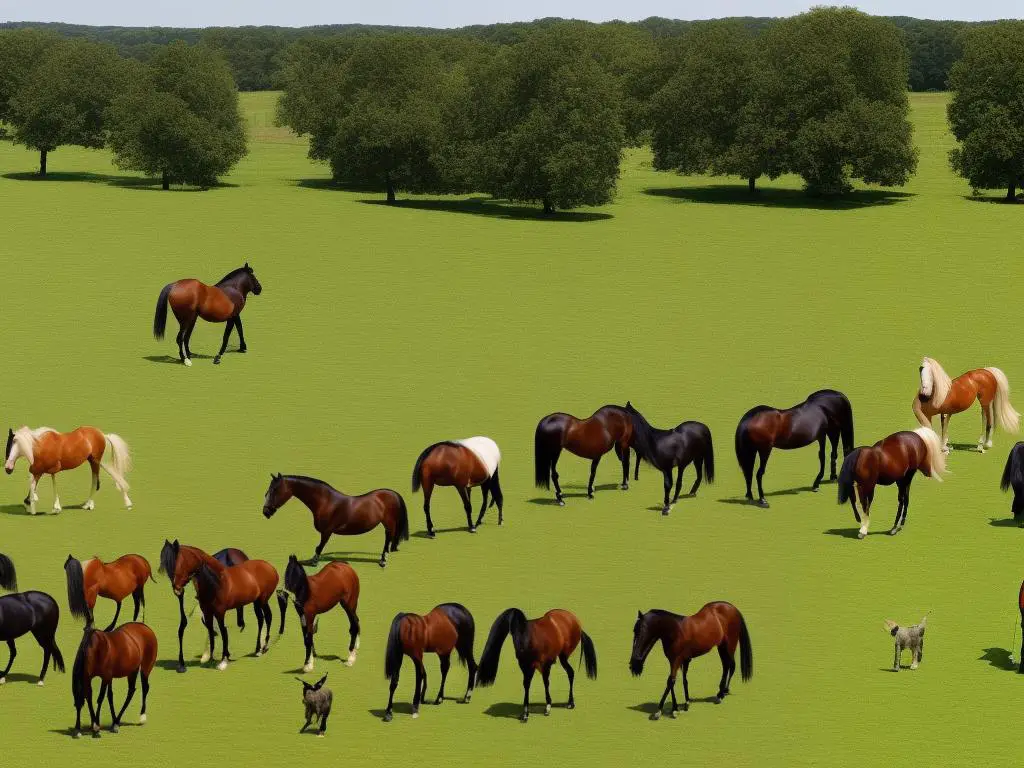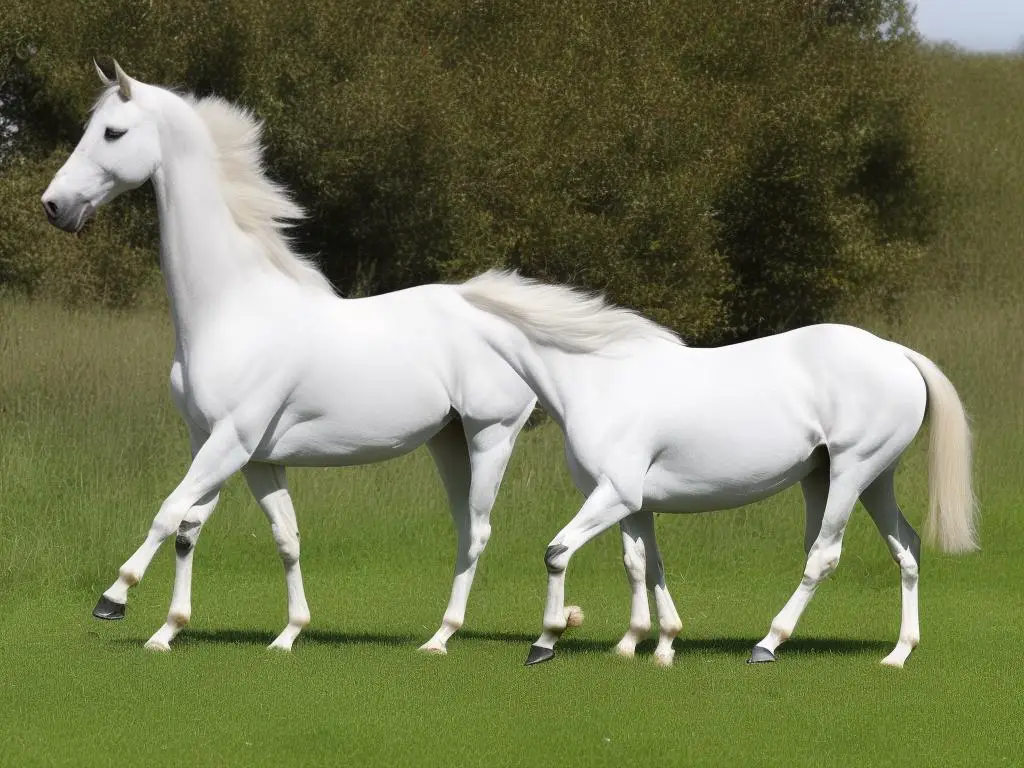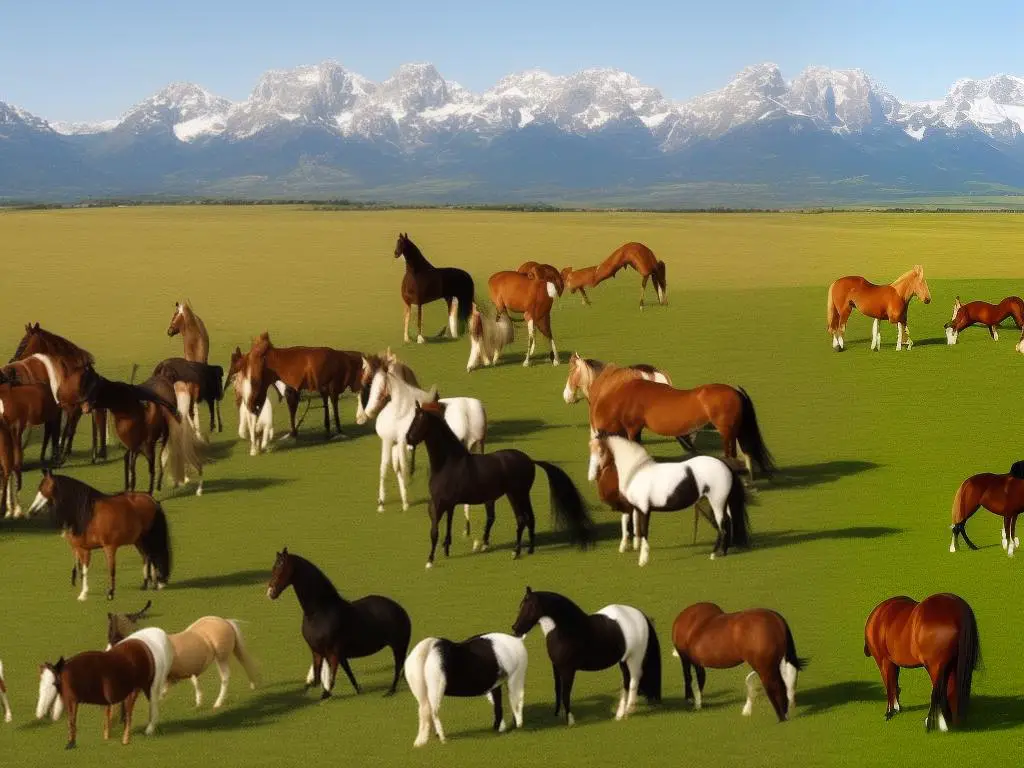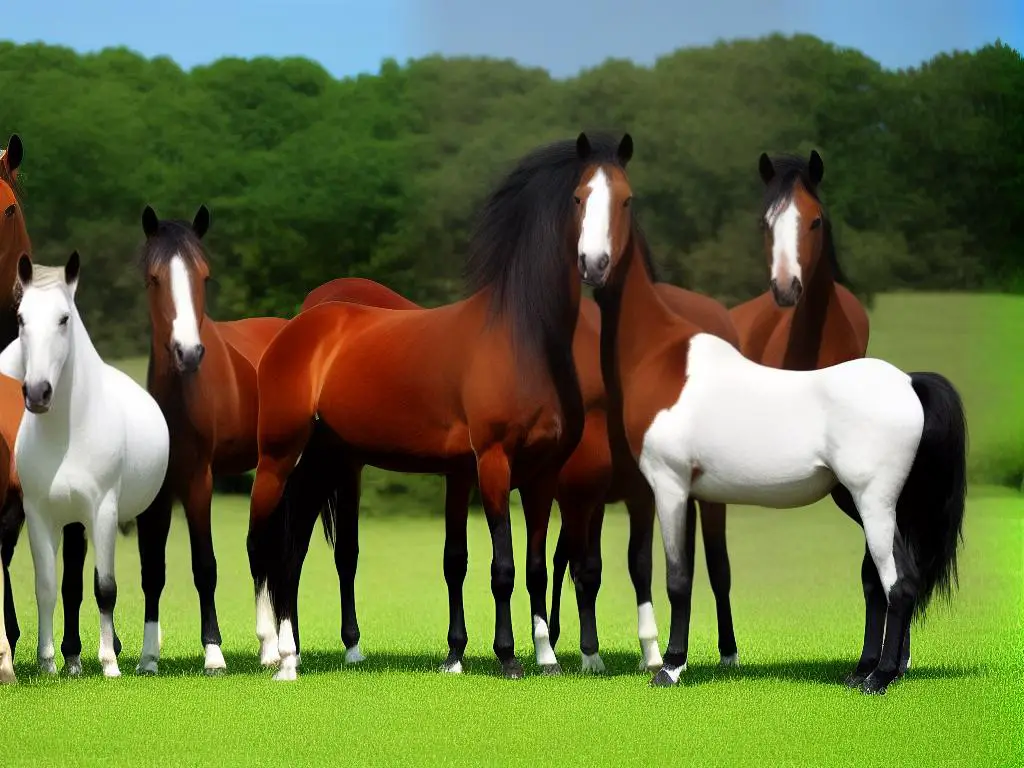France, a nation renowned for its unrivaled passion for equine tradition, has gifted the world with some of the most remarkable horse breeds. Each breed is a reflection of the regions in which they were carefully curated, carrying with them a rich blend of history, culture, and unique physical characteristics that set them apart from others. This piece aims to dive headfirst into the enchanting world of French horse breeds, exploring their historical origins, differing attributes, popular varieties and their usage, and the ever so important topic of conservation and future of these gallant creatures.
Table of Contents (Horspedia)
History and Origin of French Horse Breeds
Historical Origins of French Horse Breeds
The history of French horse breeds is deeply entwined with the development of the French nation itself. In the middle ages, knights prized large, strong horses, which led to the breeding of the Percheron, a horse still treasured for its size, strength, and striking appearance. As transport and warfare changed, so did the breeds of horse that French breeders developed.
The Influence of French Nobility
The French nobility played a significant role in the development of French horse breeds. With a strong interest in equestrian culture, they aimed to develop horse breeds that could serve both in warfare and as a status symbol. The Normandy horse and the French Trotter are notable examples of breeds that were influenced by this trend.
Development of Breed Types
Different regions in France had different requirements for horses, leading to a range of distinct breeds. Working animals used primarily for their pulling or carrying capacity differed greatly from breeds developed for speed and agility. For instance, the Auxois is a robust draft horse from eastern France that was used for heavy farmwork, while the Selle Français was bred for lighter farmwork and for cavalry use.
Breed Organization and Record Keeping
In the late 19th and 20th centuries, breed associations were established, and more stringent record keeping began. Breed standards were developed, further refining the distinct breeds. Some breeds became highly specialized, such as the French Trotter, which was developed for harness racing, and the Camargue, a breed known for its endurance and agility in the marshlands of southern France.
Significance in French Culture and History
Horses have been an important part of French culture, from medieval chivalry to the present day. They have been used in art, literature, symbolically in religious and cultural ceremonies, and as working animals in agriculture and transportation. Many historical events, such as great battles and royal processions, owe their outcomes partly to the speed and strength of French horses.
Safeguarding French Horse Breeds
Currently, French horse breeds are highly appreciated for their diverse nature, rich heritage, and notable contributions towards various equestrian tasks. Preservation of these valuable breeds is a priority for various organizations and enthusiasts who are committed to keeping these breeds from going extinct, thereby maintaining the historical legacy of French horsemanship for future generation’s appreciation.

Distinguishing Features and Characteristics of French Horse Breeds
An Overview of French Horse Breeds
French Horse breeds are internationally recognized for their multipurpose abilities, sheer elegance, and resilience. Majority of these breeds were originally bred and honed in France over numerous centuries and as a result, they possess unique attributes and traits suitable for a wide range of applications, spanning from agricultural needs to high-end equestrian sports, racing or leisure riding.
Distinguished French Horse Breeds
The French Trotter
The French Trotter, specifically bred for harness racing, is a sturdy and compact breed that typically stands between 1.50 to 1.65 meters tall. Possessing a robust neck, broad chest and potent hindquarters, this breed is perfectly suited for racing pursuits. They are commonly found with a bay, chestnut or black coat, characterized by an expressive and intelligent look. Besides remarkable trotting speed, French Trotters are also acclaimed for their endurance and spirit.
Camargue Horse
Native to the harsh environment of the Camargue marshes in Southern France, the Camargue breed is renowned for its resilience and hardiness. This petite horse breed usually stands at 1.35 to 1.50 meters tall. They are predominantly grey, although the foals are born black or dark brown. They are characterized by a compact and muscular body with a well-set neck. They possess a calm and friendly temperament, making them excellent options for trekking and trail riding.
French Saddle Pony
French Saddle Ponies or “Poney Français de Selle” are a result of crossing British ponies with small French horses. With a height of around 1.45 meters, this pony breed exhibits a coat color that varies from bay, chestnut, to grey. They are compact, well-muscled, and often show phenotypic similarities to the Thoroughbred horse. Their athletic physique and versatile genes allow them to excel in various equestrian disciplines, including jumping, eventing, and dressage.
Breton Horse
Originating from the Brittany region, the Breton Horse is one of the most robust French horse breeds. These horses are short, generally standing between 1.5 to 1.6 meters tall, with a compact and muscular physique, ideal for heavy draft work. They possess strong legs, a deep chest, and a broad forehead. Their coat colors range from chestnut to bay roan, with a feathered tail and mane. Besides their strength, Bretons are also known for their kind temperament and energetic nature.
Norman Cob
The Norman Cob or “Cob Normand,” a native breed from Normandy, is renowned for their strength, stamina, and versatility. Typically standing at 1.60 to 1.70 meters, they exhibit a powerful and muscular physique, with strong limbs, a broad chest, and a large head. They commonly have chestnut or bay coat colors. The breed is multifunctional, with uses varying from meat production to transportation, and they were traditionally used in agriculture.
Distinctive Traits of French Horse Breeds
French horse breeds are well-regarded for a variety of shared qualities that set them apart from other equines. These breeds are often lauded for their physical endurance and robustness, characteristics that contribute to their longevity and increased immunity to certain diseases. Furthermore, French horses are celebrated for their versatility across different equestrian disciplines. They strike a balance between spirited energy and calm docility, making them suitable companions for both professional riders and hobbyists.

Popular French Horse Breeds and Their Use
The Heritage and Practicality of French Horse Breeds
The value of French horse breeds goes beyond their distinct temperament and practicality. They also carry with them a rich history, in some cases spanning numerous centuries, underscoring France’s long-standing affinity for horse-raising and culture. More than just an appreciation for equines, the variety of horse breeds native to France symbolizes the country’s heritage and traditions. These horses serve various purposes, ranging from racing and agricultural tasks to participation in a panoply of equestrian sports. Aside from their utility, each breed showcases distinct personality traits, further setting them apart in their own unique ways.
The Camargue Horse: A Symbol of Freedom
Originating from the marshy Camargue region in Southern France, the Camargue horse is renowned for its statuesque beauty and resilience. Being largely associated with herdsmen who cultivate cattle in the region, this breed demonstrates a notable aptitude for work in difficult terrains. Camargue horses are also recognized for their sturdy physiques, displaying a small stature along with a large head and expressive eyes. Embodying the spirit of freedom and nobleness, they are also used for recreational riding and traditional French equestrian games.
The Thoroughbred: The Face of French Racing
French Thoroughbreds, known for their speed, grace, and endurance, dominate the world of horse racing. Bred primarily for this sport, Thoroughbreds exhibit a superior capacity for covering distances at high speed. Endowed with an intelligent and spirited nature, this breed also makes an excellent companion for sport-related activities like jumping and eventing. The success of French Thoroughbreds in international racing circles has also led to a surge in their breeding for the global horse racing market.
The Percheron: A Symbol of French Agricultural History
The Percheron’s origin traces back to the Perche province of western France, where it was typically employed for heavy draft and farm work owing to its strong build and amiable temperament. Known for their intelligence and willingness to work, Percherons are recognized by their powerful muscular build and elegance despite their size. These features have prompted their use not only in agriculture but also in hauling freight in urban areas and for leisure riding. Their stately appearance has made them popular for parade and show use as well.
The French Trotter: Engineered for Excellence
The French Trotter is a breed indigenous to France, specifically bred for trotting races. Beyond their athletic abilities, French Trotters are also appreciated for their docile and friendly nature. They have a leaner but muscular body structure, which is a characteristic trait required for trotting races. Being great learners and resilient workers, they are typically used for harness racing and often for riding after retirement from competitive sports.
The Selle Français: A Star of the Showjumping World
The Selle Français is a breed well-known globally for its prowess in showjumping events. Originating from French native horses crossbred with Thoroughbreds and Norfolk Trotters, the Selle Français possesses a synthesis of speed, agility, and power. Their strong muscular build particularly enables them to excel in sports requiring jumping abilities and swift acceleration. Additionally, their well-rounded, adaptable nature makes the Selle Français suitable for most equestrian sports.
To wrap it up, French horse breeds boast a substantial diversity, with each breed offering unique utilities that go beyond just horseback riding. Not just their functional usage, these horse breeds also show distinct character traits and personalities, further enhancing their charm and uniqueness. From the majestic and sturdy draft horses to the nimble and quick racehorses, French horse breeds undoubtedly make a distinct mark on the international horse breed arena.

Conservation and Future of French Horse Breeds
Preservation Status of French Horse Breeds
The preservation status of French horse breeds varies widely, with some falling into the endangered category, while others are prospering. For example, the Boulonnais is categorized as “endangered” in the French stud book, in contrast to the Normandy Cob, which is viewed as “not at risk.” The Auvergne horse, in contrast, is deemed “at risk,” suggesting it is slightly less endangered than other breeds.
In spite of ongoing initiatives to rejuvenate these breeds’ populations, their preservation continues to be problematic due to reasons such as the decline in rural horse husbandry and shifts in agricultural methodologies. Also, the emergence of mechanized farming equipment in the 20th century lessened the reliance on workhorses, which has led to a substantial decrease in their population numbers.
Efforts to Conserve French Horse Breeds
The French government and numerous equine organizations have implemented measures to protect and conserve these unique horse breeds. Several studbooks and breed societies have been established to monitor and maintain breed purity, such as the Société Française du Cheval de Trait Comtois for the Comtois horse breed and the Association Nationale du Poney Français de Selle for the French Saddle Pony.
Breed improvement programs are also in place, supported by incentives for breeders to encourage production. These programs typically involve a combination of selective breeding strategies, performance testing, and veterinary checks to ensure the health and quality of the horses.
In addition, preservation initiatives like the National Studs (Haras Nationaux) have been set up specifically to protect endangered French horse breeds. This institution represents a critical component in the conservation effort by maintaining a gene bank where semen and embryos from these breeds are stored.
Future Viability of French Horse Breeds
The future of French horse breeds is highly dependent on ongoing conservation efforts, policy support, and the market demand for these breeds. With the revival of interest in horse-riding and equestrian sports, some breeds, such as the French Saddlebred, have regained popularity for their sporting aptitude.
However, breeds predominantly used as workhorses continue to face steep challenges. Recognition and appreciation of their cultural and genetic value are key to their survival. Public awareness campaigns and educational initiatives could play a role in securing a sustainable future for these breeds.
To conclude, while endangered, French horse breeds could still thrive with appropriate support. By combining strategic conservation, breeding programs, and public engagement, these unique horse breeds could continue to enrich France’s equestrian heritage.

Understanding the rich tapestry of French horse breeds not only offers a glimpse into the France’s deep-rooted equestrian culture and history, but also allows us to appreciate the staggering diversity among these breeds. The sustainable measures being undertaken for these breeds’ preservation mirror the enduring love and respect for these magnificent animals. The tale of each breed invigorates our understanding of France’s cultural narrative, while the enduring measures implemented to secure their future echo hope. Together, they offer us an exquisite symphony of past, present, and future, leading us towards a more enlightened perspective on horse breeds, their importance, and their continued survival.
